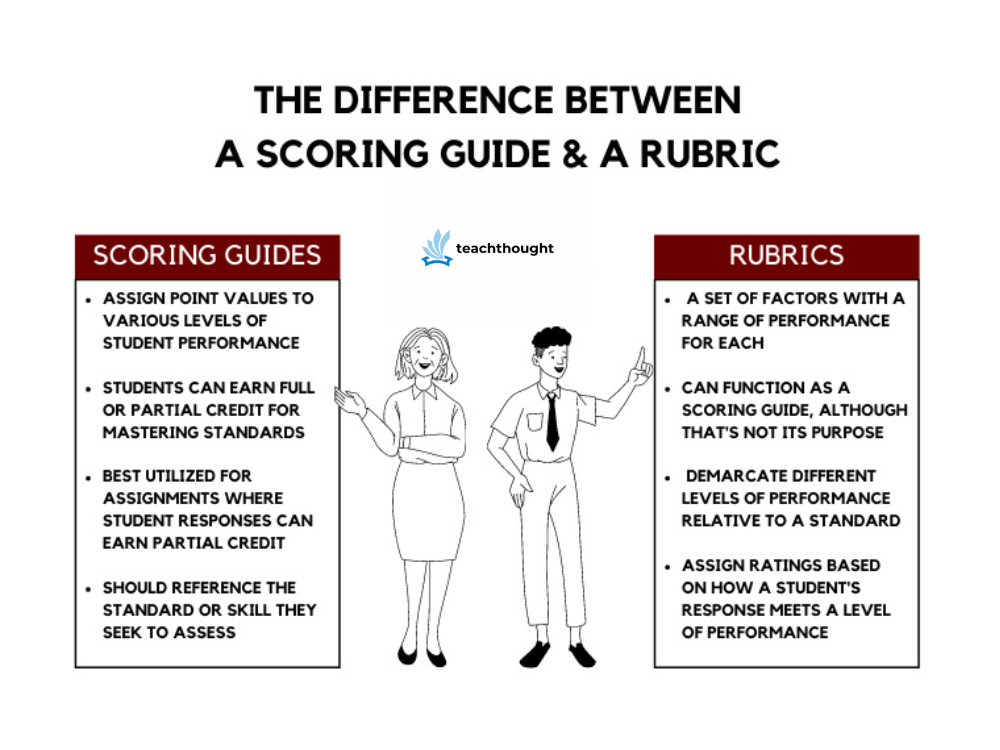What’s the difference between a scoring guide and a rubric?
After all, there’s a lot they share in common. Both scoring guides and rubrics:
- Show students how their assignments are being assessed by defining criteria and/or benchmarks in specific terms
- Can be used to help students self-assess the quality of their work and give useful peer feedback
- Have potential to reduce the amount of time teachers spend grading student work
- Purport to value objectivity over subjectivity
What Is The Difference Between A Scoring Guide And A Rubric?
While the ‘what’ is similar, the ‘how’ is where the difference between a scoring guide and rubric is most evident.
What Is A Scoring Guide?
Put simply, scoring guides assign point values to various levels of student performance. In this way, students can earn full or partial credit for mastering standards. Scoring guides are best utilized for assignments where student responses can earn partial credit, like in a constructed-response portion of an exam, or within a performance task.
Ideally, scoring guides should reference the standard or skill they seek to assess. If they can include an exemplar response, that’s even better. Such a constructed-response might be accompanied by the following scoring guide:
- 3/3 = Full credit –> Student answered all parts of the question correctly
- 2/3 = Partial credit –> Student answered most parts of the question correctly
- 1/3 = Partial credit –> Student answered some parts of the question correctly
- 0/3 = No credit –> Student answered all parts of the question incorrectly, or did not answer the question
What Is A Rubric?
In short, a rubric is a set of factors with a range of performance for each. In this way, a rubric can function as a scoring guide, although that’s not really its purpose–kind of like using a cell phone screen for a flashlight (as opposed to the flashlight it likely has built into it).
Rubrics demarcate different levels of performance (typically four) in relation to a standard. While scoring guides illustrate how students can earn a certain amount of points for specific questions and responses, rubrics assign ratings based on how well a student’s response meets a level of performance. Most rubrics label these levels in the following way:
- Exceeds expectations
- Meets expectations
- Approaches expectations
- Does not meet expectations
What Kind Of Feedback Do Scoring Guides And Rubrics Provide?
From comparing the two styles of assessment, you can summarize the difference in a scoring guide and a rubric in the following way: scoring guides assess quantity while rubrics assess quality. We can then conclude that scoring guides are teacher-centered (prioritizing efficiency of grading over meaningful feedback), while rubrics are student-centered (prioritizing meaningful feedback over the efficiency of grading).
How?
Inherently, a scoring guide is not set up to stimulate feedback. For each question on a multiple-choice or constructed response-themed exam, the least amount of feedback a student could receive comes in numerical form.
In a multiple-choice test, the student may see an X next to their incorrect answer, never learn the correct response, or never get the opportunity to discover the correct response independently. The problem is that a simple number does not communicate where a student erred, or how they might have been more successful.
A rubric, at the least, communicates how close a student came to achieving a specific standard. In either situation, the teacher will hopefully communicate more feedback to students, particularly if they received partial credit or merely approached expectations.
When Should I Use A Scoring Guide Vs. A Rubric?
Since scoring guides are tailored to efficiency, they may be ideal to use in low-stakes, formative assessments that don’t necessarily get entered into the gradebook.
While scoring guides allow for partial credit, they might be best utilized for questions or problems that have a single correct response or way to achieve the response (like a mathematical problem or matching/labeling question).
Rubrics should be used with any assessment–formative or summative–where the teacher wishes to clearly communicate how the student can progress.
Performance tasks, writing assignments, and portfolio assessments should ideally be assessed with a rubric, particularly since there is more room for subjectivity in these matters. Rubrics should also be utilized when teachers want students to perform self-assessments, as they provide clear indicators of performance.
Whether using scoring guides or rubrics, educators should clearly explain their expectations for each assignment, and describe how each assessment form functions to help the teacher gauge student progress. The truth is, it depends on what information the teacher–and students–need.
Teachers should align indicators with skills that they have taught and practiced with students — no student should be evaluated on a task or skill they haven’t yet learned. Ultimately, when designing a scoring guide or rubric, it can be reduced to a simple question: Who needs what information and what’s best way for them to get it?
What does the teacher need?
What does the student need?
In The Definition Of Authentic Assessment For Learning, Grant Wiggins frames what authentic assessments should accomplish:
- They should be essential to learning, as opposed to serving as a machine to produce a grade
- They should be complex and contextualized, and demand necessitate higher-level thinking
- They should be transparent in ways that demystify expectations for student performance
- They should include self-assessment as part of the overall assessment
- They should center feedback and orient students toward ways to grow or build upon existing knowledge
Both scoring guides and rubrics can accomplish these tasks in their own ways. The question for educators is, which assessment form is best suited for the task at hand, and how can I use it to provide meaningful feedback to my students?
